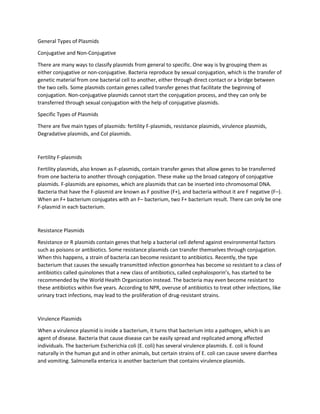
classification of plasmid and its typed.docx
- 1. General Types of Plasmids Conjugative and Non-Conjugative There are many ways to classify plasmids from general to specific. One way is by grouping them as either conjugative or non-conjugative. Bacteria reproduce by sexual conjugation, which is the transfer of genetic material from one bacterial cell to another, either through direct contact or a bridge between the two cells. Some plasmids contain genes called transfer genes that facilitate the beginning of conjugation. Non-conjugative plasmids cannot start the conjugation process, and they can only be transferred through sexual conjugation with the help of conjugative plasmids. Specific Types of Plasmids There are five main types of plasmids: fertility F-plasmids, resistance plasmids, virulence plasmids, Degradative plasmids, and Col plasmids. Fertility F-plasmids Fertility plasmids, also known as F-plasmids, contain transfer genes that allow genes to be transferred from one bacteria to another through conjugation. These make up the broad category of conjugative plasmids. F-plasmids are episomes, which are plasmids that can be inserted into chromosomal DNA. Bacteria that have the F-plasmid are known as F positive (F+), and bacteria without it are F negative (F–). When an F+ bacterium conjugates with an F– bacterium, two F+ bacterium result. There can only be one F-plasmid in each bacterium. Resistance Plasmids Resistance or R plasmids contain genes that help a bacterial cell defend against environmental factors such as poisons or antibiotics. Some resistance plasmids can transfer themselves through conjugation. When this happens, a strain of bacteria can become resistant to antibiotics. Recently, the type bacterium that causes the sexually transmitted infection gonorrhea has become so resistant to a class of antibiotics called quinolones that a new class of antibiotics, called cephalosporin’s, has started to be recommended by the World Health Organization instead. The bacteria may even become resistant to these antibiotics within five years. According to NPR, overuse of antibiotics to treat other infections, like urinary tract infections, may lead to the proliferation of drug-resistant strains. Virulence Plasmids When a virulence plasmid is inside a bacterium, it turns that bacterium into a pathogen, which is an agent of disease. Bacteria that cause disease can be easily spread and replicated among affected individuals. The bacterium Escherichia coli (E. coli) has several virulence plasmids. E. coli is found naturally in the human gut and in other animals, but certain strains of E. coli can cause severe diarrhea and vomiting. Salmonella enterica is another bacterium that contains virulence plasmids.
- 2. Degradative Plasmids Degradative plasmids help the host bacterium to digest compounds that are not commonly found in nature, such as camphor, xylene, toluene, and salicylic acid. These plasmids contain genes for special enzymes that break down specific compounds. Degradative plasmids are conjugative. Col Plasmids Col plasmids contain genes that make bacteriocins (also known as colicins), which are proteins that kill other bacteria and thus defend the host bacterium. Bacteriocins are found in many types of bacteria including E. coli, which gets them from the plasmid ColE1. Related Biology Terms Bacteria – Single-celled microbes that were one of the first types of lifeforms to evolve on Earth; they can exist independently or inside other organisms. Episomes – In bacteria, a plasmid that can be inserted into the chromosome. In eukaryotes, plasmid refers to non-chromosomal DNA that can be replicated in the nucleus, such as a virus. Conjugative – A category of plasmids that start the process of sexual conjugation in bacteria.